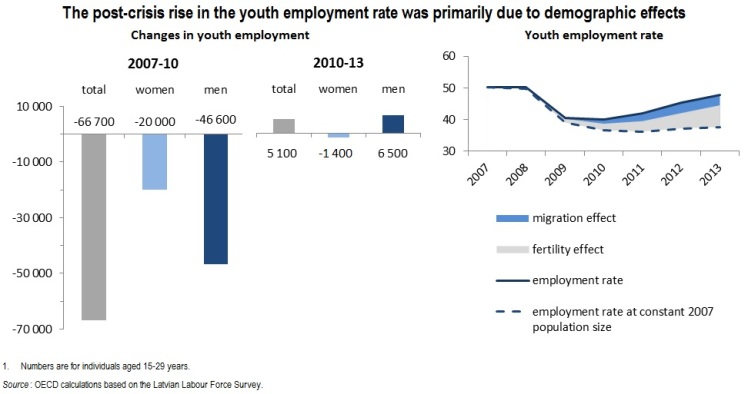By Sebastian Königs.
Latvia faces a huge demographic challenge. Since restoration of its independence in 1991, the country lost more than a quarter of its resident population. In 2015, the population dropped below 2 million for the first time since the 1950s, down from 2.7 million in 1989.
The drivers of this trend are twofold: Fertility rates plummeted during the transition years in the early 1990s, andremain worryingly low even today. More importantly, however, Latvians have been leaving their country in scores, attracted by greater job opportunities and higher wages paid in the UK, Ireland or elsewhere in Europe. Official statistics indicate that 430 000 Latvians have emigrated since the late 1980s, but research suggests that the actual number may have been even higher (Hazans, 2013).
The Great Recession, which had a devastating effect on Latvia, further reinforced the trend towards emigration. GDP plummeted by 26% between 2008 and 2010, causing unemployment rates to more than triple for working-age persons and young people (to 20% and 28%, respectively). As a result, net emigration increased more than fourfold to over 40 000 persons annually in 2010.
Since young people in their 20s and early 30s are more prone to emigrate, it is vital for Latvia to provide them with a perspective of quality jobs to be able to turn the tide of emigration. Unfortunately, despite rapid labour market recovery after 2010, only very few new jobs have been created for young people. Instead, the observed rebound in the share of young people in employment mostly reflects the fact that there were simply many fewer young people around after the crisis (see Figure).
To fully exploit the potential of its shrinking work force, the recent OECD report Investing in Youth: Latvia points out that promoting upper-secondary school completion should remain a priority for Latvian decision makers. While rates of early school leaving have fallen, they remain high for young men, students in rural areas and those enrolled in vocational education programmes. A more systematic sharing of school attendance information in upper-secondary education between schools and municipal social services could help ensure that at-risk youth with non-educational barriers quickly receive the help they need.
Latvia also needs to pursue recent efforts to modernise its vocational education system. As pointed out earlier on this blog, the provision of relevant practical training can help smooth school-to-work transitions by raising programme attractiveness while providing young people with valuable labour market skills. Vocational education in Latvia has long suffered from a poor reputation and low enrolment numbers. While the country has already taken important steps to consolidate its network of vocational training institutions, redesign training programmes, and invest in training facilities, vocational education remains school-centred with only few elements of work-based learning. Youth would benefit from more company-based learning, ideally in the form of an apprenticeship system that allows trainees to learn on the job for the duration of the training. This would require an appropriate legal framework that sets quality standards and specifies the rights and obligations of employers, students and educational institutions.
For youth out of school, the recently launched Latvian Youth Guarantee introduces an entitlement to employment or training participation within the first four months of unemployment. The reform has rightly focused on extending active labour market programmes participation among young jobseekers, including enrolment in comprehensive “second-chance” training programmes, and on improving outreach to disengaged youth. The recent OECD report concludes, however, that the low capacity of employment and social services, and an insufficient co-operation between these services, represent crucial challenges for an effective delivery of employment support to young jobseekers.
Investing in youth, by upgrading skills and promoting employment, is a priority if Latvia wants to offer its young people a positive outlook and address the demographic challenge.
Additional resources:
OECD work on youth: http://www.oecd.org/youth.htm
OECD Action Plan on Youth: http://www.oecd.org/employment/action-plan-youth.htm


One thought on “Investing in youth is key for fixing Latvia’s demographics”